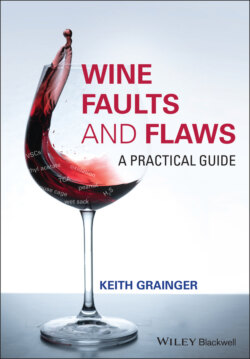Читать книгу Wine Faults and Flaws - Keith Grainger - Страница 18
1.6 Faults and Taints
ОглавлениеGenerally in the food and drink industries, a distinction is conventionally made between the terms ‘fault’ and ‘taint’. A taint may be defined as an ‘unwanted and unacceptable odour or flavour; a contaminant derived from an external source including the environment and packaging’. Equipment used in wine production processes, additives, and processing aids (e.g. bentonite), the winery atmosphere, transport containers, and packing materials including cork bottle closures can be sources of taints. Rather simplistically, the ISO defines a taint as a ‘taste or odour foreign to the product originating from external contamination’ [11]. Conversely, a fault may be considered to be an internal chemically or microbiologically produced off‐odour, off‐flavour, or cause of product deterioration. Oxidation and the off‐flavours from fermentative sulfur compounds are examples of faults. Biological and enzymatic degradation of compounds such as fatty acids frequently result in off‐flavours. Whilst faults may be due to poor or careless winemaking, care and diligence throughout the production, and packaging processes are also necessary to minimise the risk of taints.
However, the technical distinction between ‘faults’ and a ‘taints’ is not always clear, and restricting the use of the words in a such narrow manner makes little sense. For example, so‐called ‘smoke taint’ affects grapes, being adsorbed onto the skin of berries and translocated to grapes via leaves. However, it is the compounds that are created (metabolised) during winemaking that give smoke‐taint associated off‐odours and flavours. The so‐called ‘rogue’ yeast Brettanomyces produces compounds that may give off‐odours and flavours, and the words contaminant and taint are often used in this regard. For example Manuel Malfeito‐Ferreira talks of the ‘horse sweat’ taint when reviewing the impact of Brettanomyces [12]. In a restaurant, the diner rejecting a wine that exudes the damp, musty odours of the TCA compound, always derived from an external source such as a cork closure or even the cellar atmosphere, will inform the sommelier or waiter that it is faulty (or corked), and is most unlikely to use the descriptor ‘tainted’. In fact, at low levels, TCA compounds will not actually taint a wine, but will strip it of fruitiness and result in tasting very flat. Accordingly, a wine contaminated with TCA, other than at miniscule levels of concentration, will not always be tainted, but will always be faulty. Further, many researchers use the word ‘taint’ in papers when discussing what are technically faults, as do many professional wine writers and authors. David Bird MW, speaks of ‘reductive taint’ in his book Understanding Wine Technology (3rd Edition), which is used by many wine students worldwide studying for the internationally recognised Diploma examination of the Wine and Spirit Education Trust [5]. Dr Eric Wilkes of the Australian Wine Research Institute (AWRI) refers to reduced aromas, oxidation, and Brettanomyces as taints [13]. Accordingly, I consider that the word ‘fault’ should be regarded as an all‐encompassing descriptor for something that is wrong with a wine (to include any taint or other contamination) that results in a significant off‐odour or flavour, a marked reduction of quality, or is adverse to human health. For the sake of both clarity and simplicity, it is generally used as such in this book.
